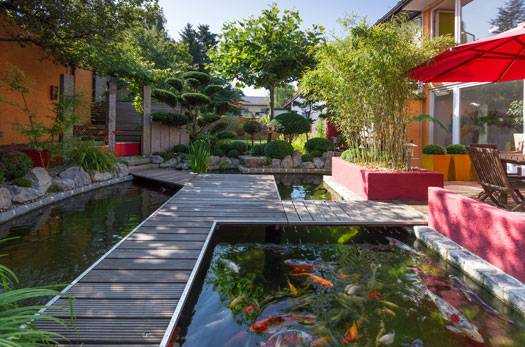- Your shopping cart is empty!
Is It Necessary to Have a Pump in a Koi Pond?

In the wild, a pond’s ecosystem is self-sustaining. Each plant, fish, and microorganism helps the others thrive by maintaining a balance of chemicals and nutrients in the water. But can manmade ponds replicate this process on their own, or do they need a helping hand? The conventional wisdom among koi pond keepers leans resoundingly toward the latter. When planning and creating your koi pond, the same considerations apply as they do to an indoor fish tank. In small tanks, filters are considered sufficient aeration. In larger tanks and in ponds, a filter alone is unlikely to move enough water to keep the fish healthy. Here’s why pumps are one of the most important koi pond supplies and what you need to know about these important devices.
Oxygen and Carbon Dioxide
Oxygen and carbon dioxide are essential to animal and plant respiration. Koi and other fish take in oxygen and respirate out carbon dioxide, which can build up in still waters quickly. Plants take in carbon dioxide and put out oxygen, but often in insufficient amounts. Remember not every pond that occurs in the wild becomes a home for thriving fish—and it’s difficult to perfectly replicate plant, microorganism, and fish ecosystems that have existed over decades or centuries when building your pond in a matter of weeks. Just as filters create extra room for microorganisms involved in the nitrogen cycle, aeration pumps aid in a degree of oxygenation that pond plants alone can’t produce on the same level as a wild lake that’s thrived for decades upon decades. In addition, if your pond reaches temperatures of 80°F or above, aeration is an absolute must.
Choosing a Pump System
Read the recommendations of each aeration system you’re considering to choose a pump (or multiple pumps) that moves the right volume of water for your pond. When choosing a pump, keep both the fish population and pond size in mind. If your pump disturbs the water enough to swirl your fish around in its current, consider one or two less powerful systems in its place.
Monitoring the Aeration Pump
Once your aeration pump has been installed, keep an eye on the behavior of your koi to know if it’s doing its job right.
Insufficient Aeration
In a sufficiently aerated pond, koi won’t feel the need to stick close to the surface or swim upward to “gasp” for oxygen from the air or surface water. This gasping behavior is unsustainable—it’s a sign your fish need more oxygen, or they risk suffocation. Remember to always have your pumps running 24 hours a day or you’ll quickly lose beneficial bacteria that’s needed for the health of your fish and pond.
Excessive Aeration
Overzealous aeration, wherein too much oxygen is introduced to the environment, is more likely to affect plant life than fish, so if your plants are struggling, consider whether there’s too much churning in too small of a pond. Total oversaturation of a pond with dissolved gasses can cause the less common, but fatal, gas bubble disease. Dissolved gasses in the bloodstream can change in pressure and present as visible bubbles seen on the fish’s skin or around their eyes. Rectify oversaturated water by stirring or otherwise aerating it vigorously to expel excess gas, performing an immediate water change, and downgrading to a more appropriate aeration system. Just-right levels of aeration should leave your fish healthy, active without darting, and breathing easy. However, it’s always better to overdo the aeration than to under-aerate.
If you need a high-quality pump for your koi pond or any other important pond equipment, Aquatic Warehouse can provide just what you need. Check out our website, stop by our store in Kearny Mesa, or give one of our aquatic experts a call at 858-467-9297.
